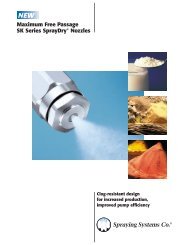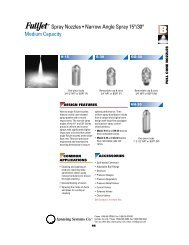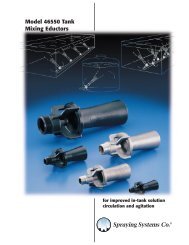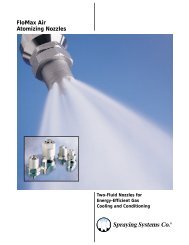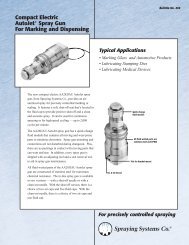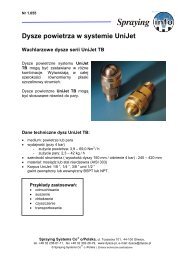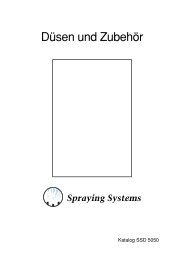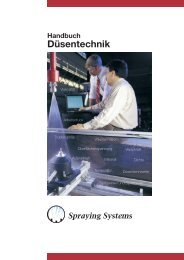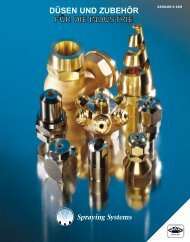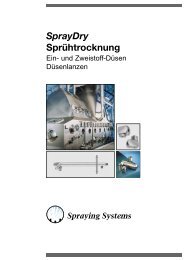A Guide to Safe and Effective Tank Cleaning
A Guide to Safe and Effective Tank Cleaning
A Guide to Safe and Effective Tank Cleaning
Create successful ePaper yourself
Turn your PDF publications into a flip-book with our unique Google optimized e-Paper software.
Identify the best spray pattern for<br />
your level of cleaning<br />
Solid stream sprays provide the greatest impact, followed<br />
by flat fan <strong>and</strong> full cone sprays. Typically, fixed spray<br />
nozzles with full cone sprays are used for gentle rinsing<br />
<strong>and</strong> washing. Fluid driven nozzles with flat fan sprays<br />
offer more impact <strong>and</strong> are commonly used for cleaning.<br />
High-pressure, mo<strong>to</strong>r driven <strong>and</strong> turbine driven nozzles<br />
use solid streams for maximum impact.<br />
Evaluate your tank design <strong>to</strong> identify<br />
spray coverage <strong>and</strong> obstructions<br />
<strong>Cleaning</strong> coverage provided by various spray angles ranges<br />
from 65 <strong>to</strong> 360 degrees. Multiple nozzles may be required if<br />
a spray cannot reach a part of the tank due <strong>to</strong> internal<br />
obstructions such as a mixer or agita<strong>to</strong>r.<br />
Types of <strong>Tank</strong> <strong>Cleaning</strong> Nozzles<br />
High-pressure (mo<strong>to</strong>r driven)<br />
Two <strong>to</strong> four nozzles rotate on a<br />
mo<strong>to</strong>r driven gear hub<br />
• Solid stream, high impact nozzles<br />
clean stubborn residue<br />
• High impact reduces the water<br />
required for effective cleaning<br />
• Lightweight, portable<br />
• Recommended for cleaning<br />
medium <strong>to</strong> large tanks<br />
• Liquid pressure <strong>and</strong> rotational speeds<br />
are independently controlled<br />
Fluid driven (reactionary force)<br />
Rotational velocity increases as pressure increases<br />
• Good impact <strong>and</strong> coverage, less fluid consumption<br />
• Wide variety of materials available<br />
• Sanitary design features<br />
• Recommended for rinsing<br />
<strong>and</strong> cleaning small tanks<br />
Fluid driven (constant speed)<br />
Rotates at constant speed as<br />
pressure fluctuates<br />
• Slow rotational speed improves<br />
impact <strong>and</strong> throw<br />
Determine the duration of the cleaning cycle<br />
Most cleaning cycles last from 10 <strong>to</strong> 30 minutes <strong>and</strong><br />
include three <strong>to</strong> four stages: pre-rinse, which should<br />
remove 90% of the soil; cleaning; post-rinse <strong>and</strong> sanitizing.<br />
• Low liquid consumption<br />
• Recommended for cleaning<br />
<strong>and</strong> sanitizing small tanks<br />
Select a nozzle material <strong>and</strong> connection type<br />
appropriate for your application<br />
For most applications, stainless steel nozzles are<br />
used for their durability <strong>and</strong> ability <strong>to</strong> withst<strong>and</strong> high<br />
temperatures. For corrosive applications, nozzles made<br />
of polytetrafluoroethylene (PTFE) or polyvinylidene fluoride<br />
(PVDF) are preferred. For sanitary applications, st<strong>and</strong>ards<br />
may require special consideration for nozzle design,<br />
mounting specifications <strong>and</strong> materials of construction.<br />
Fixed (stationary)<br />
Multiple orifice assemblies stay<br />
in position while spraying<br />
• Simple design, no moving parts<br />
• Wide range of spray coverage<br />
• No mounting limitations<br />
• Recommended for rinsing small tanks<br />
1.800.95.SPRAY | Intl. 1.630.665.5000 | www.spray.com<br />
7



